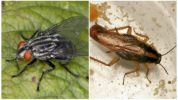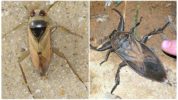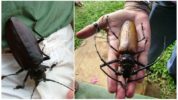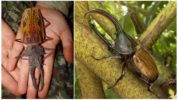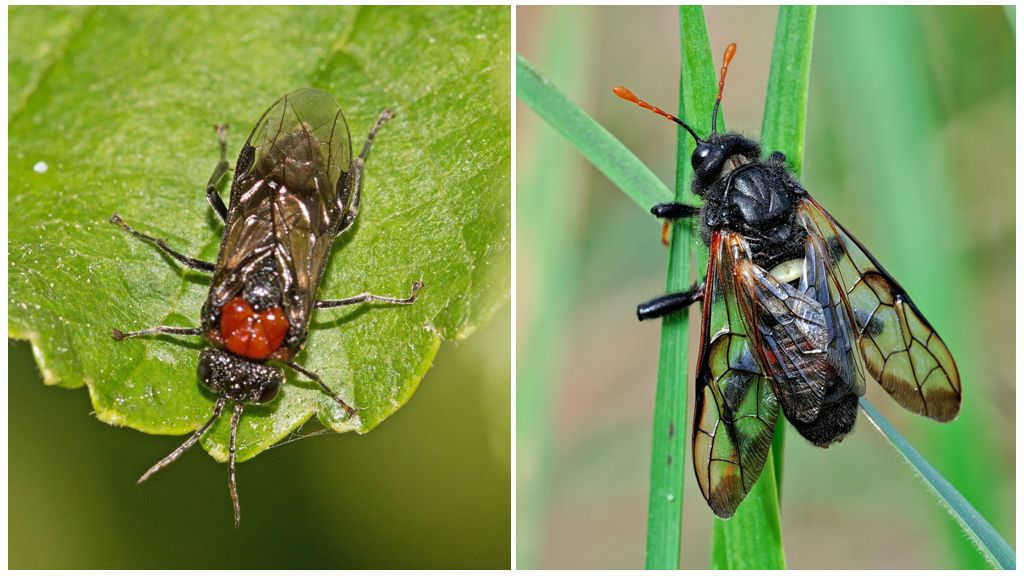- Gray meat fly and red cockroach
- Scary insects
- Water bugs
- Giant lumberjack
- Brazilian Lumberjack Lumberjack and Hercules Beetle
The concept is the most terrible insects in the world, for everyone it is different. Some are afraid of the size of the insect, others are of the appearance, others are poisonous, and others are more squeamish than fear. These creatures can be scary, vile, disgusting, dangerous. The only missing nomination is the ugliest insect. Ugliness - distortion of proportions and underdevelopment / overdevelopment of organs. Among the species that have undergone a million-year evolution, there can be no ugly ones. But in every form an ugly individual can be found.
The most nasty insects
The antithesis criteria for different people differ from each other, but no one will argue that the larvae of a gray meat fly on a corpse or a cockroach in the kitchen are a pleasant sight. If approached from this point of view, the most vile insects will be:
- gray meat fly of the family Sarcophagidae;
- red cockroach / Prusak (Blattella germanica);
- head louse (Pediculus humanus capitis).
These insects are unlikely to cause real fright, but disgust and disgust are guaranteed.
Gray meat fly
Large two-winged insect 1-2.5 cm long. Color gray with longitudinal black stripes on the thoracic region. On the abdomen, black color may be present in the form of transverse stripes, dots, or a mesh pattern.
On a note!
Flies are viviparous. Moving larvae climbing from the abdomen of a dead insect is an unpleasant sight. But a live birth gives meat flies advantage over the carrion.
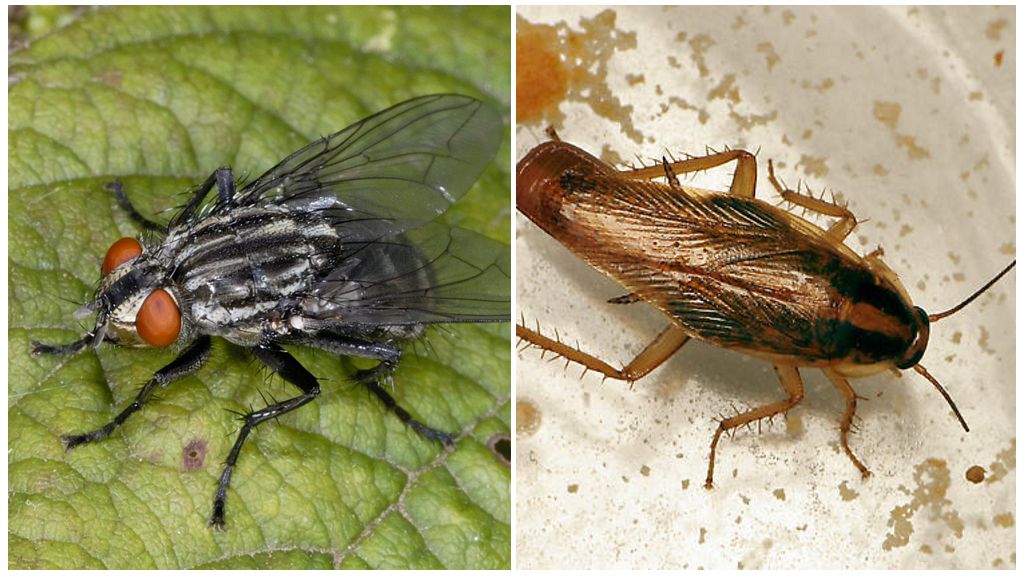
Red cockroach
Few people do not know what this synanthropic pest looks like. The insect with a body length of 1.5 cm has a tan color. On the upper side of the chest, two stripes are darker in color than the main background. The mustache is long, the head is small.
The female lays eggs in the ooteca, which she carries with her until the offspring hatch. The cockroach has developed wings, but the insect does not like to fly.
Prefers to live in the kitchen. He leads a nocturnal lifestyle, hiding in the cracks, if you turn on the light. It feeds on everything it can find. These eating habits cause disgust in people. Insects can easily move from the bin to the table for good food.
By birth red cockroach from South Asia and dies already at a temperature of -5 ° C. For this reason, in the northern latitudes it can exist only in heated rooms.
On a note!
If a huge cockroach is seen in the house, this is not a mutant, but periplanet americana. The homeowner has recently returned from warm countries or from America.
Periplaneta American
Almost an exact copy of the red cockroach, but 5 times larger. It has a dark brown color without darker stripes. In habits and lifestyle, it is completely identical to the red relative. This species is a native of Central Africa, from where it was introduced to many countries.
Head louse
Long gray insect no more than 4 mm long. The head is very small, much smaller than the cephalothorax. Paws are ideally suited for clinging to hair. Eats head louse blood. Lives and multiplies on the scalp in humans.Few people are not disgusted by the sight of these insects crawling on the head of a nearby person.
Ants
Photo of the scariest insects in the world - closeup photo of ant heads. In most cases ants and so do not cause emotion. But if you look at the image of the head of a nomadic ant, Eziton Burchellii and recall that nomadic ants usually do not leave anything alive, it’s easy to conclude that these insects are monsters. The only thing that saves humanity is that nomadic ants are inhabitants of the tropics.
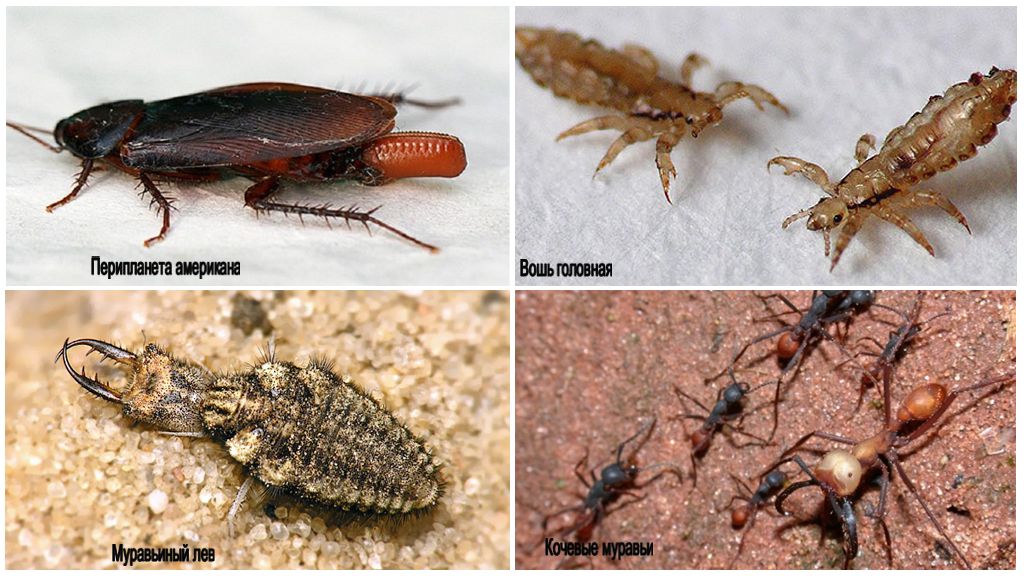
Ant lion
A graceful dragonfly-like insect. The body length is about 3.5 cm. The wingspan is 8 cm. The imago feeds on nectar of flowers. But this beautiful insect has a terrible larva that gave Spielberg an idea with a sarlak.
On a note!
The larva hides in sandy soil, where it awaits prey. In an ordinary ant lion, a larva digs out a funnel where careless ants and bugs roll down. Invertebrates are no longer destined to get out of the funnel. The larva catches them with long bent mandibles.
Medvedka
A strange insect that looks like a cross between a beetle and a cricket. The body length of the bear is 5-8 cm. The color is dark brown. The abdomen is 3 times larger than the cephalothorax. At the end of the abdomen there are paired filiform appendages.
The chest is protected by a hard shell. Medvedka can hide his head under it. The insect is armed with two powerful forepaws, with which it breaks through the ground in the ground. The bear spends all its life underground. For a person, the bear is safe, but you do not want to touch it again.
Water bugs
These are not harmless "stinks" that live on plants and drink juice. Water bugs - merciless and very fast predators. Their victims are all with whom the individual is able to cope.
Belostomatids
Giant water bugs, body shape similar to the well-known in Russia smoothies. The color is black. Truly infernal creatures. Not only sizes are scary: these individuals can grow up to 15 cm. All bugs fly well and white-stomatids are no exception. The forelegs of a predatory water bug turned into peaks-trap. They feed on small fish and lizards. They can eat a young turtle. These creepy insects can bite very painfully. The largest and most terrible representatives of the family of water bugs live in tropical regions. Belostomatids of somewhat smaller sizes are common in Central and North America, as well as in Australia.
On a note!
Few people know that in Russia there are also giant water bugs. The species Lethocerus deyrollei lives in the Amur Region, Japan, Korea and China. The size of this bug is relatively small: 5-6.5 cm. The species belongs to the relic and is on the verge of extinction.
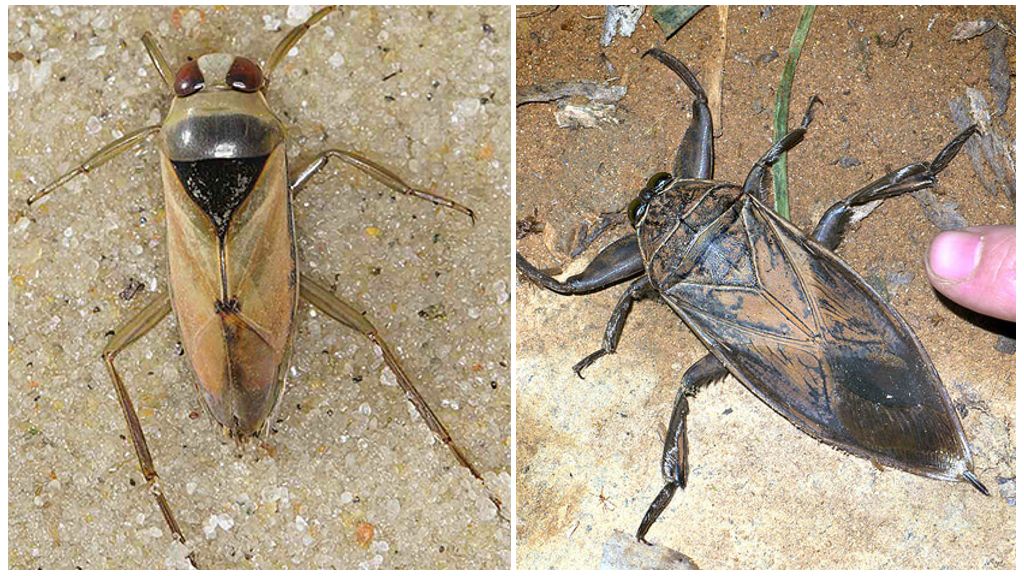
Gladysh
A small “relative” of Bialystomatids possesses the same qualities as large water bugs. Outwardly, this is a reduced copy of Bialystomatids. Even biting smoothies is very painful. But the size of the bug-wasp is only 1.5 cm, which saves a person from the serious consequences of a bite.
Beetles
To call even huge beetles scary, few people come to mind. They are absolutely not dangerous to humans and can scare unless the size. Some beetles are larger in size than the giant water bugs - white-breasted. But all the bugs are vegetarians. Most of them are very rare and poorly studied. These insects are actively hunted for sale to collectors. So these beetles should be afraid of people, and not vice versa. Not very scary and biggest bugs in the world:
- woodcutter-titan (Titanus giganteus);
- Brazilian lumberjack (Macrodontia cervicornis);
- Hercules beetle (Dynastes hercules);
- goliath beetle (Goliathus regius);
- stag beetle (Lucanus cervus);
- Ussuri relic barbel (Callipogon relictus).
The last two beetles live in Russia, but are very rare.
Giant lumberjack
Inhabitant of the Amazon basin. The insect is so rare that the sources diverge even in determining the size of the beetle. Either his maximum body length is 8-17 cm, or 17-22. The average size of insects is 13 cm.Nobody saw the larva. Comparing the sizes of other longhorn beetles with their larvae, entomologists suggested that the size of the giant lumberjack larva should be 26-34 cm.
Interesting!
The cost of the largest copies for the collection is 680-1000 dollars.

The color of the beetle is dark brown. Mustache half body. Leads a nocturnal lifestyle. In the afternoon hides in hollows, forest litter, rotten stumps. An adult does not eat at all in 3-5 weeks of its life. The larva feeds on rotting plant organics.
Brazilian Lumberjack
Range - tropics of South America. The maximum length is 17 cm. Almost half falls on long, jagged and curved mandibles. Development can last up to 10 years in the larval stage. The larva is 21 cm long.
Interesting!
The larva of this insect is brown. The beetle has a very beautiful color: on a brown background, the elytra is a pattern of yellow lines.
Hercules Beetle
The range is again Central and South America. It lives in moist forests. The length of the largest recorded beetle is 17 cm. On average, 12.5-14.5 cm. Half the length falls on a pair of horns located in a vertical plane. One, longer, on the pronotum. Another, shorter, on the head. The length of the females is 8 cm. There are no horns.
Male color: head and pronotum black, shiny; elytra color varies. It depends on air humidity and the elytra can be painted in yellow, olive-brown, yellow-olive colors.
The imago is starving. The larva feeds on rotten wood. The period of the larval stage is 1.5-2 years. By the end of development, the larva reaches a length of 18 cm and a weight of 100 g.

Goliath beetle
Range - Equatorial Africa. The average size of males is 8.5–9.6 cm. The maximum length is 11.6 cm. Females are 5–8 cm. Color is black with a white pattern on the upper body. An adult insect lives for six months. Leads a daily lifestyle. It feeds on tree sap and rotten fruit.
Stag beetle
The largest European beetle. Range: Europe, Western Asia, north-west of Kazakhstan, North Africa. The size of the insect can vary greatly depending on the habitat. Average measurements: male 4.5-8.5 cm, female 2.5-5.7 cm. Maximum recorded size 10 cm.
The head is very large, flattened. Mandibles in the male are long, well developed. In the female, the mandibles are almost invisible. The color is brown, the head and pronotum are darker. The pronotum and head of the male occupy more than half of the total length. In the female, the ratio is the opposite: the abdomen is longer than the head and pronotum.
Interesting!
The development of the larval stage is 6 years. The larva feeds on rotten wood. Due to deforestation of deciduous forests and sanitary cleansing, the number of stag beetle is declining. The insect is listed in several Red Books, including the Russian one.
Ussuri relic barbel
Other names:
- relic barbel;
- Ussuri relic lumberjack;
- relic lumberjack.
Keyword: relict. The insect is a relic of the Tertiary period and the only representative of the tropical genus Callipogon. It lives in the Amur Region in the Far East.
Males 6–11 cm, females 6–9 cm. Habitats are broad-leaved and mixed forests. The development time of the larva is 4-6 years. They develop in drying deciduous trees. They feed on rotting wood.
Adult insect drinks wood juice. Beetles lead a daily lifestyle. The body color is black, elytra brown-chestnut.
On a note!
Ussuri barbel is the largest beetle in Russia.
Due to logging and poaching, it belongs to endangered species and is listed in the Red Book.
